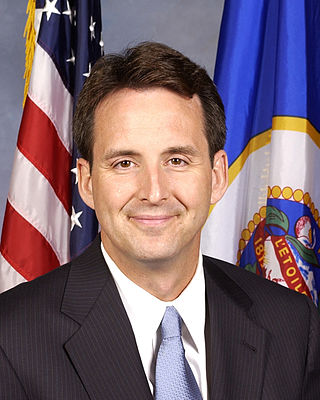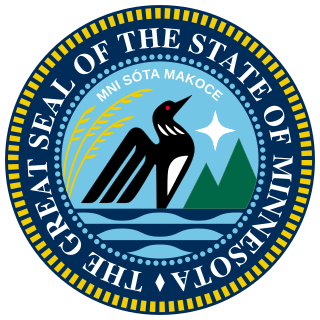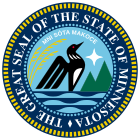
Timothy James Pawlenty is an American attorney, businessman, and politician who served as the 39th governor of Minnesota from 2003 to 2011. A member of the Republican Party, Pawlenty served in the Minnesota House of Representatives from 1993 to 2003, and as House Majority Leader from 1999 to 2003. He unsuccessfully ran for the Republican presidential nomination in the 2012 presidential election.

The Minnesota House of Representatives is the lower house of the U.S. state of Minnesota's legislature. It operates in conjunction with the Minnesota Senate, the state's upper house, to craft and pass legislation, which is then subject to approval by the governor of Minnesota.
Steven A. Sviggum is a Minnesota politician, a member of the University of Minnesota Board of Regents, and an executive assistant to and communications director for the Republican caucus in the Minnesota Senate. A former Speaker and member of the Minnesota House of Representatives, Sviggum represented District 28B in the southeastern part of the state. The area was known as District 25A until the 1982 legislative redistricting, and then as District 26A until the 1992 redistricting, and has included all or portions of Dakota, Dodge, Goodhue, Olmsted, Steele, Wabasha, Waseca and Winona counties.

Paul Thissen is an American politician and jurist serving as an associate justice of the Minnesota Supreme Court. He previously served as the Speaker of the Minnesota House of Representatives and DFL Minority Leader. Thissen was the longest-serving leader of the Minnesota House Democrats since Martin Olav Sabo in the 1970s. A member of the Minnesota Democratic-Farmer-Labor Party (DFL), he represented District 61B in south Minneapolis. First elected in 2002, Thissen was reelected every two years through 2016. On April 17, 2018, Governor Mark Dayton appointed Thissen to the Minnesota Supreme Court. He was sworn in on May 14, 2018. He is the first person to have served both as Minnesota House Speaker and on the Minnesota Supreme Court.

Melissa Hortman is an American politician and the Speaker of the Minnesota House of Representatives. A member of the Minnesota Democratic–Farmer–Labor Party (DFL), Hortman represents District 34B in the northern Twin Cities metropolitan area, which includes the cities of Brooklyn Park, Champlin and Coon Rapids and parts of Anoka and Hennepin Counties.
Satveer Singh Chaudhary is an American criminal defense and immigration lawyer. He is also a politician and a former member of the Minnesota State Senate and the Minnesota House of Representatives serving from 1996 to 2010.

The eighty-second Minnesota Legislature first convened on January 3, 2001. The 67 members of the Minnesota Senate and the 134 members of the Minnesota House of Representatives were elected during the General Election on November 7, 2000.

Lawrence "Larry" J. Pogemiller is an American politician from Minnesota, and the Commissioner of the Minnesota Office of Higher Education. A member of the Minnesota Democratic-Farmer-Labor Party, he represented northeast Minneapolis districts in the Minnesota Legislature from 1981 to 2011, and served as the Senate's 9th majority leader from 2007 to 2011. As majority leader, he was chair of the Senate Rules Committee and its subcommittees, and also served on the Senate Tax Committee.

Ron Erhardt is a politician from the U.S. state of Minnesota and former member of the Minnesota House of Representatives. He represented District 49A, which included most of Edina in Hennepin County.
The following table indicates the party of elected officials in the U.S. state of Minnesota:

Michelle Louise Helene Fischbach is an American attorney and politician who is the U.S. representative from Minnesota's 7th congressional district. The district, which is very rural, is Minnesota's largest congressional district and includes most of the western area of the state. A Republican, Fischbach served as the 49th lieutenant governor of Minnesota from 2018 until 2019. As of 2024, she is the most recent Republican to have held statewide office in Minnesota.
Elections were held in Minnesota on Tuesday, November 2, 2010. Primary elections took place on August 10, 2010.
Edward Arthur Burdick was a nonpartisan former chief clerk and parliamentarian of the Minnesota House of Representatives and the past national president of the American Society of Legislative Clerks and Secretaries (ASLCS).

The eighty-first Minnesota Legislature first convened on January 5, 1999. The 67 members of the Minnesota Senate were elected during the general election of November 5, 1996, and the 134 members of the Minnesota House of Representatives were elected during the general election of November 3, 1998.

The seventy-fourth Minnesota Legislature first convened on January 8, 1985. The 67 members of the Minnesota Senate were elected during the General Election of November 2, 1982, and the 134 members of the Minnesota House of Representatives were elected during the General Election of November 6, 1984.

The Ninetieth Minnesota Legislature was the legislature of the U.S. state of Minnesota from January 3, 2017 to January 7, 2019. It was composed of the Senate and the House of Representatives, based on the results of the 2016 Senate election and the 2016 House election. It first convened and held its regular session in Saint Paul from January 3 to May 22, 2017, and from February 20 to May 20, 2018. A special session to complete unfinished business was held from May 23 to 26, 2017.

The Ninety-first Minnesota Legislature is the legislature of the U.S. state of Minnesota from January 8, 2019 to January 4, 2021. It is composed of the Senate and House of Representatives, based on the results of the 2016 Senate election and 2018 House election. It first convened and held its regular session in Saint Paul from January 8 to May 20, 2019, and from February 11 to May 18, 2020. A special session was held from May 24 to 25, 2019, to pass bills enacting the state budget following an agreement between the governor and legislative leaders during the final weekend of the regular session in 2019.
The 1980 Minnesota House of Representatives election was held in the U.S. state of Minnesota on November 4, 1980, to elect members to the House of Representatives of the 72nd Minnesota Legislature. A primary election was held on September 9, 1980.

The sixty-ninth Minnesota Legislature first convened on January 7, 1975. The 67 members of the Minnesota Senate were elected during the General Election of November 7, 1972, while the 134 members of the Minnesota House of Representatives were elected during the General Election of November 5, 1974. The sixty-ninth Legislature was the first Minnesota Legislature to sit after the repeal of the requirement that Minnesota legislators be chosen in legally nonpartisan elections.

The Ninety-second Minnesota Legislature is the legislature of the U.S. state of Minnesota from January 5, 2021, to January 3, 2023. It is composed of the Senate and House of Representatives, based on the results of the 2020 Senate election and 2020 House election.
















